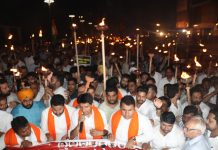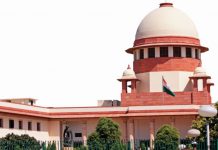
The boats of vegetables and pulses that touch the Brahmaputra river bank in Guwahati every morning are mostly grown in the hundreds of fertile sandbars, locally called chars that dot the 800-km stretch of the mighty river of Assam — from Sadiya in the east to Dhubri in the west.
Though chars in the eastern parts of Assam are inhibited by the ethnic Mising tribes, the immigrant Muslims who had migrated to Assam from erstwhile Pakistan, even during the British reign, dominate the western parts which is close to present Bangladesh.
The similar living condition and the alluvial land in neighbouring Bangladesh and in Assam’s sandbars continue to attract the migrant Bangladeshis. The trend, however, has turned into a political issue in Assam over the decades as the sandbars are considered to be the den of “illegal migrants” from Bangladesh that threaten Assam’s demography and deepen the fear of identity crisis among the state’s ethnic tribes.
A committee constituted by the BJP-led government in the state that came to power in May 2016, said that chars have become a “safe haven for illegal migrants from Bangladesh” and is pushing the growing threat of identity to indigenous people of the state.
How do they Cross the International Boundaries?
The five-member committee, which submitted its report to Assam government in April this year said Bangladeshi migrants enter through the porous stretch of 1880-km Indo-Bangladesh borders that touches Assam, Meghalaya, Tripura and Mizoram.
According to a report it says, “The Border Security Forces (BSF) or other paramilitary forces that are entrusted with guarding the borders make their job easy by allowing these seekers of greener Pasteur in Assam to cross the border for a little personal gain. It is an open secret that anyone who wants to enter in to Assam has only to pay 200 or so.
In fact, the whole process of the immigration is conducted by well-knit special agencies or organisations that operate on both sides of the borders and take over the entire process of depositing the infiltrators in the Assam side of the borders. Before they cross the border, they are reportedly given language training, names of their destination and contacts on arrival in Assam.
Some private Madrassas are reported to play dominant roles in the whole process of sending such consignments to Assam. On reaching Assam, the infiltrators are taken over by the respective assignees who utilize their vibrant network to various destinations allotted to each and the process goes on silently and smoothly perennially.
And the Government of Assam finds no reason to be concerned with such arrivals which causes definite threats to the land rights of the indigenous citizens of Assam as also to their very identity.”
How do they settle in the sandbars?
The committee report said all lands in the char areas virtually belong to and are settled by a well-established institution known as Matabbar or Dewani. For all practical purposes, they play the real role of the government, making allotment of land to or settling land with new arrivals of the infiltrators from across the international borders, collecting revenue, exercising monopolistic authorities over the settlers who live there at the complete mercy of the Matabbar and controlling all facets of their activities.
They are the real Zamindars and wield tremendous political and financial clouts such that nobody can gather any courage to raise any voice against them if they want to live there or be alive at all. “To inject fear psychosis in their mind, the Matabbar has his ready weapon of threatening to get them detected by police.
So the Matabbar exercises the full power of the absenting government authorities and make allotment or settlement of land to the new arrivals of suspected Bangladeshis, give them money for being settled at highly exorbitant rate of interest and, in addition to keeping them in perpetual fear and control, the Matabbar builds the way to exploit them in all conceivable way, often treating the victims as animals,” said the report.
Gravity of the Problem
The Char villages spreading from Dhubri to Sadiya comprise a total area of 3,609.27 sq. Kms (2003-04) and accounts for 4.60 per cent of the state’s total geographical area. There are 2,251 Char villages spread in 14 of the state’s 36 districts and occupying 3,609. 27 sq. Kms of land with the Char area being the largest in Dhubri followed by Jorhat district, suggesting that the demography of Assam was fast changing due to high population growth rate in the char areas. The total population of the char areas in 2003-04 was 24.9. lakhs, with an explosive growth rate of 195.83 per cent in Dhubri (between 1992-2003) 98.85 per cent in Nagaon, 51.58 per cent in Jorhat, 58.30 per cent in Sonitpur and 59.25 per cent in Tinsukia.
“The most distressing point of concern is that almost all the settlers are either immigrants from erstwhile East Pakistan or Bangladesh, a section of whom has now become citizens as per the Assam Accord, 1983, or they are illegal Bangladeshis coming after 24 March, 1971- all living together without the illegal Bangladeshis being identified,” said the report.
The ploy to grab Assam land
The report says as the chars are in total control of the illegal migrants, they often wander in other places in Assam for jobs and new areas for encroachment. “While so wandering, they have their ploy handy and plead that they are flood and erosion-affected people displaced from their home Barpeta or Dhubri districts. They take advantage of the fact that the illegal Bangladeshis of Assam have not been identified and pose that they are citizens of India.”
“The fact, however, remains that they neither understand anything of the local language nor are they acquainted with the locality they want to grab. Their invisible leaders guide them and teach them one or two things about the local language or culture to hoodwink the local indigenous people or the police authority. Once they successfully grab the new lands/ areas in the community, they take the full benefits of the flood relief under the disaster management department of Assam government.
They, however, are different from the large population of indigenous Muslims in Assam. In fact, indigenous Muslims continue to complaint of fear of losing their identity from the Bengali speaking Muslims from Bangladesh.
Detection of illegal migrants
Assam, meanwhile, is about to update the National Register of Citizens 1951 to segregate its citizens and illegal migrants, mainly from Bangladesh. The NRC is being updated with Mach 24, 1971 as the cut-off date under the supervision of the Supreme Court, which directed the Centre to complete the exercise by June 30 this year.
This means those proving their/their forefathers’ stay in Assam (with documents) till March 24, 1971, will be enrolled as Indian citizens and those failing to do so will be identified as illegal migrants from Bangladesh.
Threat to ecology
The chars or sandbars are temporary accretions formed due to deposits of the silts carried by the river Brahmaputra and are highly susceptible to demolition due to strong river current during the high annual floods. As the report said, “When human habitation in the char obstructs its natural or new courses, it either demolishes the existing char or takes the easier route to maintain its unobstructed course by eroding new villages on its banks.
How different Assam sandbars from Bangladesh?
The report said the basic features of the chars of Assam and Bangladesh are same except that the average cropping intensity of the chars of Assam is more than that of Bangladesh probably because unlike in the chars of Bangladesh, the seawater alkaline components in the chars of Assam are non-existent. And, with the plentiful growth of luxuriant vegetation, high cropping intensity with minimum labour, fishing, boating and thatching opportunities, and above all, the absence of government administration and encouragement by both the “communal politicians and the Government of Assam, lured by vote bank politics, the chars of Assam have become the paradise of illegal Bangladeshis. Interestingly, human habitation in the chars of Bangladesh is known to be banned by Bangladesh government.
Who are the members of the committee?
The report was submitted by five members of the committee — former IAS officer Rohini Kumar Baruah, Gauhati University Law College dean Ramesh Borpatragohain, senior Gauhati High Court advocate Anil Bhattacharya, former Assam MLA Ajoy Dutta and a commissioner and secretary of the state revenue department.
What do Muslim organisations say?
Some Muslim organisations, however, see this report as “a ploy by the BJP government” to tag all char dwellers as illegal Bangladeshi migrants. They said the chars are mostly inhibited by Muslim migrants who were either brought by the British to grow food items in Assam or had settled in Assam before March 24, 1971, the cut-off date decided in the 1985 Assam Accord, for detection and deportation of foreigners.
letters@tehelka.com













